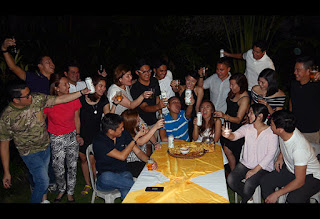Sika silib mo ton telepono! As of 2019, the
average daily social media usage of internet users worldwide amounted to 144
minutes per day, up from 142 minutes in the previous year. Currently, the
country with the most time spent on social media per day is the Philippines,
with online users spending an average of three hours and 53 minutes on social
media each day. In comparison, the daily time spent with social media in the
U.S. was just two hours and three minutes. This is reported by J. Clement on
February of this year via Statista.
Relationships are
created and destroyed on these sites. There are even instances that the social
media portals are unhealthy to those whose personalities are not founded on
mature psychological roots. Envy and self-pity sprout as these persons look at
the posts and adventures of their virtual friends. At the back of their minds
they are saying: Why can’t I have a similar life like theirs? Not realizing
that the posts can be blown out of proportion or simply projected/induced by
those who post them.
The fear of missing
out (FOMO) refers to the feeling or perception that others are having more fun,
living better lives, or experiencing better things than you are. It involves a
deep sense of envy and affects self-esteem. It is often exacerbated by social
media sites like Instagram, Twitter and Facebook.
Scott (2020) mentions
that social media has accelerated the FOMO phenomenon in several ways. It
provides a situation in which you are comparing your regular life to the
highlights of others' lives. Therefore, your sense of "normal"
becomes skewed and you seem to be doing worse than your peers. You might see
detailed photos of your friends enjoying fun times without you, which is
something that people may not have been so readily aware of in past
generations.
Social media creates
a platform for bragging; it is where things, events, and even happiness itself
seems to be in competition at times. People are comparing their best,
picture-perfect experiences, which may lead you to wonder what you are lacking.
That is the reason
why some persons whom you do not expect to do things out of the ordinary do
outrageous posts “just for fun”. Actually, they fear that they are missing out
if they do not go with the flow. Some of them have to do it to feel they are in
step with the present reality. There is nothing wrong about it as long as they
are still in control with themselves… that the real SELF is still intact. But
it is another story when these things cause anxiety or stress. These situations
if undetermined and uncontrolled can lead to depression.
Some adults are
wondering why a lot of kids these days are easily depressed. One of the valid
reasons is that they are constantly exposed to social media sites and that they
are prone to wonder why their lives are not as fabulous as their friends’. Most
of them feel that they are missing out.
FOMO can be
experienced by people of all ages, several studies have found. One study in the
Psychiatry Research journal found that the fear of missing out was linked to a
greater smartphone and social media usage and that this link was not associated
with age or gender.
As technology enables
us to stay more connected than ever, the addiction continues to grow. In fact,
a new survey conducted by MyLife.com revealed 56% of people are afraid of
missing out on events, news and important status updates if they are away from
social networks.
One of the things
that we need to understand as well is that there is what we call as the SILENT
OBSERVERS in these platforms. They seem to be inactive in these sites but they
are more prone to opening them so not to miss out. They feign nonchalance but
they are more active compared to those who post shout outs, TikToks and
pictures on the sites. They are following the movements of their virtual
friends in an “inactive way”.
There are few
articles about the ‘Silent Observers’ on Facebook according to Borkar (2015). There
is power of having these quiet followers who read every post, see every content
without clicking ‘Like’, ‘Comment’ or ‘Share’ no matter how engaging they might
find the content. They simply judge and weigh your worth through your posts.
These silent
observers are also on the verge of leading towards the unhealthy feeling and
having the fear of missing out. They are part of that percentage that spend a
lot of time scrolling up and down looking for information or the latest posts
for the sake of observing and sometimes finding flaws and missteps. Then, they
would feel good since the mistakes presented by others can soothe their own
egos. They will then be assured that they are better than those they see erring
on social media.
This writer considers
these sites as spaces. They are like papers to be written; photo albums to be
pasted with pictures and even a blank canvass to be painted. The “likes” and “dislikes”
are not that important aside from the affirmation from friends and relatives.
There are around 300 journals with a myriad of contents kept in a drawer.
Nobody reads them. The contents are made for self-consumption and not for others' scrutiny or jealousy. Most of them are
outputs of the processes created out from multiple inputs gained.
Social media fosters
CONNECTION. Other than that can be another psychological discourse. Positive
inputs, processing and outputs can be made. A balance of CONSUMPTION and
CREATION can be done here. Anxiety, depression and envy caused by the fear of
missing out must be avoided. One can even disconnect themselves from these sites. It won't kill you!
In the end, our
mental health is our sole responsibility.









